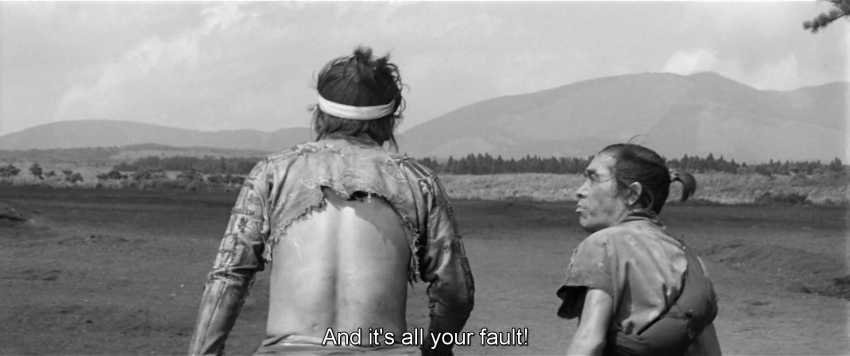Star Wars & the Hidden Fortress
December 7, 2015 · 0 comments
By Hugh David.
With Star Wars: The Force Awakens on the immediate horizon, it is worth remembering how important the original Star Wars was in widening the Western audience for Japanese storytelling and action. American filmmaker George Lucas drew on a wide range of influences in bringing his third feature to the screen, including 1930s American SF “cliff-hanger” episodic film serials such as Flash Gordon and Buck Rogers, WW1 And WW2 “dogfight” movies and Japanese period samurai films. The most notable of these in relation to Star Wars: A New Hope was maverick Japanese director Akira Kurosawa’s 1958 film The Hidden Fortress, a debt openly acknowledged by Lucas himself time and again (including in a lengthy interview on the U.S. Criterion Collection edition of Fortress) and repaid when Lucas produced Kurosawa’s epic Kagemusha. Obvious elements such as the bickering comedy characters used to tell the story and the main arc of a samurai general (the great Toshiro Mifune, whom Lucas approached about playing Obi-wan Kenobi before Guinness) and young princess behind enemy lines have been much remarked upon (for those wanting the short version there’s a YouTube video that juxtaposes relevant shots), but perhaps at this date the most important thing is not what Lucas borrowed, but what effect his borrowings had on the huge and often very young audience that became entranced with his magpie cinematic vision.
 The very style of the film, the character types, combat styles and the mysterious Force opened a lot of young minds to the story elements common in Japanese and Chinese movies, TV and cartoons. It’s no surprise that Monkey, The Water Margin and Battle of the Planets would become massive TV hits, or that ninja would come to dominate international TV and film soon after. Star Wars also ushered a huge global cross-media boom in SF; it’s no surprise that one anime industry exec described the effect 1979’s Mobile Suit Gundam had on his generation at school as being like Star Wars; certainly, that franchise has become similarly enduring and internationally beloved. The demand for kid-friendly SF and fantasy in France led to the importation and co-production of several anime, notably Space Pirate Captain Harlock, giving rise to the “Generation Harlock” who made France the single most important export market for anime in Europe this century.
The very style of the film, the character types, combat styles and the mysterious Force opened a lot of young minds to the story elements common in Japanese and Chinese movies, TV and cartoons. It’s no surprise that Monkey, The Water Margin and Battle of the Planets would become massive TV hits, or that ninja would come to dominate international TV and film soon after. Star Wars also ushered a huge global cross-media boom in SF; it’s no surprise that one anime industry exec described the effect 1979’s Mobile Suit Gundam had on his generation at school as being like Star Wars; certainly, that franchise has become similarly enduring and internationally beloved. The demand for kid-friendly SF and fantasy in France led to the importation and co-production of several anime, notably Space Pirate Captain Harlock, giving rise to the “Generation Harlock” who made France the single most important export market for anime in Europe this century.
 However, the final, slightly surprising twist in the tale came in 2008 when Shinji Higuchi, director of Nadia: Secret of the Blue Water, Vandread: Turbulence and the live-action Attack on Titan movies, remade Kurosawa’s original as Hidden Fortress: The Last Princess. His direction and the film’s look and style all reference A New Hope as much as The Hidden Fortress, with special effects and a villain dressed in black who resembles a medieval Sith Lord, while the fight between Hiroshi Abe’s General Rokurota and Kippei Shina’s Gyobu is modelled on the Luke/Vader fight in The Empire Strikes Back. None of this saves the film from being a lesser work than the two originals, but it’s not a bad weekend matinee’s viewing.
However, the final, slightly surprising twist in the tale came in 2008 when Shinji Higuchi, director of Nadia: Secret of the Blue Water, Vandread: Turbulence and the live-action Attack on Titan movies, remade Kurosawa’s original as Hidden Fortress: The Last Princess. His direction and the film’s look and style all reference A New Hope as much as The Hidden Fortress, with special effects and a villain dressed in black who resembles a medieval Sith Lord, while the fight between Hiroshi Abe’s General Rokurota and Kippei Shina’s Gyobu is modelled on the Luke/Vader fight in The Empire Strikes Back. None of this saves the film from being a lesser work than the two originals, but it’s not a bad weekend matinee’s viewing.
Will Star Wars: The Force Awakens show any Eastern influences other than the ones already inherent in the saga? Will it be as influential as its forebears? For now, based on the trailers, the biggest reference points seem to be the existing films and the Knights of the Old Republic videogames, but all will be revealed soon enough.
Star Wars: The Force Awakens is released internationally this month.
A New Hope, film, George Lucas, Hidden Fortress, Japan, Shinji Higuchi, Star Wars, The Last Princess

Leave a Reply